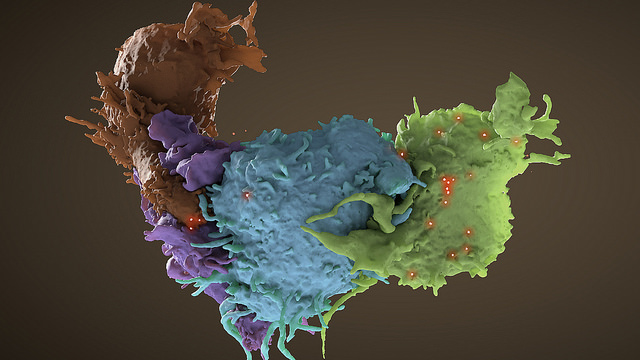
Using gene therapy, U.S. researchers have created chimeric antigen receptor (CAR)-engineered hematopoietic stem/progenitor cells (HSPCs) that have shown potential to treat HIV and other infections that can re-emerge after many years of suppression or dormancy.
The CAR-engineered HSPCs were successfully engrafted in the bone marrow of pigtail macaques infected with simian human immunodeficiency virus (SHIV), resulting in the generation of virus-targeting cytotoxic T cells that destroyed infected cells, the researchers reported.
The team of researchers from the University of California, Los Angeles (UCLA), the Fred Hutchinson Cancer Research Center, and the University of Washington, added that that the CAR-engineered HSPCs persisted in the animals for more than two years.
“This demonstrates for the first time the safety and feasibility of HSPC-based therapy utilizing an HIV-specific CAR for suppressed HIV infection,” the researchers wrote.
The researchers published their findings in PLOS Pathogens, in a study titled: “Long-Term Persistence and Function of Hematopoietic Stem Cell-Derived Chimeric Antigen Receptor T Cells in a Nonhuman Primate Model of HIV/AIDS.”
CAR T cells represent a “powerful immunotherapy” for treating different forms of cancer and have shown promise as an approach for treating HIV infection, notes senior UCLA author Scott G Kitchen, Ph.D., and colleagues. However, current methods have focused on engineering peripheral T cells, which may not persist over the long term and so fail to tackle cancers or infections that can reappear months or years after initial treatment.
In contrast, HSPCs can successfully engraft in recipients over long periods of time. Thus, HSPCs engineered to carry HIV-targeting CARs could feasibly provide a lifetime supply of CAR T cells that continue to tackle any re-emerging infection.
“Stem cell-based expression of CARs contributes a long-lived source of these cells, capable of providing lifelong immune surveillance against recrudescent virus,” the authors observed. “In contrast, adoptive transfer of CAR-modified T-cell products must overcome barriers including immune exhaustion, limited trafficking to tissues, and lack of functionality at these sites.”
An additional benefit of CAR-based therapy using modifying HSPCs, the authors continued, is that the engineered blood-forming cells will undergo normal T-cell differentiation and selection, “eliminating potentially self-reactive T cells and increasing the potential for the development of immunological memory.”
HIV infects immune cells by interacting with the host cell’s CD4 molecule. Previous studies by Dr. Kitchen’s team using humanized mice had demonstrated that HSPCs modified with a protective CD4 CAR could successfully differentiate into CD4CAR-expressing T cells and suppress HIV, “suggesting a high degree of feasibility in redirecting immunity with an HSPC-based approach.”
For their primate studies, the researchers engineered HSPCs taken from pigtail macaques with a protective CD4 chimeric antigen receptor (C46CD4CAR), which effectively “hijacks the essential interaction between the virus and the cell surface molecule CD4,” to direct HSPC-derived T cells against the infected cells. The engineered HSPCs were then reimplanted back into the same host animals, which were subsequently infected with SHIV. Twenty-four weeks following infection, the animals were given combination antiretroviral therapy (cART) for another 28 weeks to suppress the virus, after which the cART therapy was withdrawn.
The studies confirmed that the CAR gene-modified HSPCs successfully engrafted in the primates and persisted for nearly two years. The CAR-expressing HSPCs also expanded in response to SHIV infection and differentiated into SHIV-targeting effector T cells. Interestingly, the level of CAR T-cell response mirrored the SHIV antigen level.
“Intriguingly, we found that CAR cells contracted during cART treatment during lower levels of antigen expression, followed by a rapid expansion after cART withdrawal, mimicking a memory response,” the team wrote. “As a result, CAR animals had decreased viremia during post-cART viral rebound as compared to control animals.”
Encouragingly, the CAR cells were found in multiple lymphoid tissues, including those of the gut, which is a major site for HIV replication and persistence, and there was no evidence of toxicity associated with the treatment. Compared with control animals, macaques transplanted with the autologous CAR-engineered HSPCs exhibited much lower SHIV mRNA levels in the lymph nodes, gut, and brain.
“These results set the stage for future attempts to eradicate viral infection and provide more effective immune surveillance for HIV, using optimized CAR vectors and combinatorial approaches,” the team noted. “We demonstrate that HIV/SHIV-specific CAR cells possess strong antiviral activity even at low levels…. These cells should act as sentinels, generating a robust immune response to reactivated infected cells months or years after they are introduced, without requiring expression in a high percentage of immune cells.”
The researchers said that while their studies could also lay the foundation for the development of CAR-engineered HSPCs against other diseases: “Importantly, these findings have broad implications beyond HIV. Additional preclinical studies should be performed to explore HSPC-expressed CARs against other infectious diseases and cancer in greater detail.”






![AI Algorithm Could Reduce Breast Cancer Mammogram False Positive Rate The primary goal of the Paradigm Registry is to accelerate tumor profiling based on disease biology. [iStock/LilliDay]](https://www.insideprecisionmedicine.com/wp-content/uploads/2019/01/307-218x150.jpeg)






